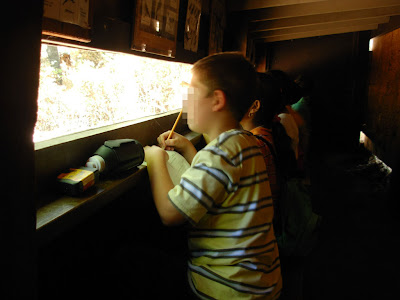
A student found this mushroom near the blind-walk. It now lives on the touch table in the Discovery Hut.

This is the beehive, where we can see how the bees live, reproduce, and make honey. These folks are probably trying to find the queen bee.

The touch table in the discovery hut, where we have many different animal remains that were found somewhere out in the woods.

Can you spot this bird? Pretty good camouflage. It's a spotted towhee. During this class, in fact, it was spotted by at least 12 students. *hahaha*

Here are the students who did the spotting.

Students exploring the pond found some algae.

These students are enjoying some fresh wild grapes that grow in the woods near the garden, after a run through the sprinkler on a hot day.

Descending into Moaning Caverns

The students get to watch their teacher rappel down a 165 foot rope into the depths of Moaning Caverns.

40 people can easily sit atop the Discovery Stump at Calaveras Big Trees State Park. The tree was the largest in the grove until it was felled in the 1850's. The stump was turned into a dance floor, and the fallen log became a single lane bowling alley. The novelty was the size of the tree, of course. Today, the tree stands as a monument to what might have been. What choices do we make now that influence the future?

A giant sequoia cone (Sequoiadendron giganteum) from our trip to Calaveras Big Trees State Park. It's about the size of a chicken's egg, and seeds about the size of a quick oat come out from between the cracks when the cone dries out. The cones can open and release seeds as a result of fire, or after being severed from the tree (thus losing moisture) by storms or animals.




uhh is that an acorn ?
ReplyDeleteIf you mean the last photo, it's not an acorn, but does serve the same function as an acorn: reproduction. It's the cone of a giant sequoia tree. See the text below the image for more info.
ReplyDelete